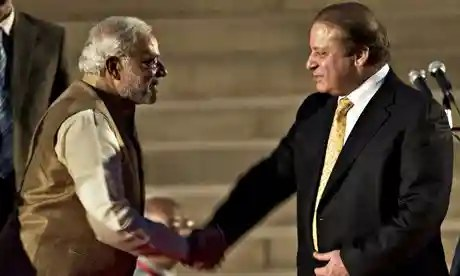New Delhi
Narendra Modi had taken over as Prime Minister of India on May 26, 2014. People's mandate was truly a historic one; Modi made it more hard-hitting and emphatic when he invited his Pakistani counterpart Nawaz Sharif for the swearing in ceremony.
Sharif also agreed. Modi also broad based it by inviting other SAARC government and nation heads. Both stole media limelight and for both it was a calculated risk.
Looking back into the last nine years, we know Modi delivered and his voters
and admirers cannot grudge him trying -- giving it a shot, as they put it. For his part,
Nawaz Sharif faced much bigger uphill task and his attempts were stonewalled.
In 2017, I had interacted with a Pakistani diplomat and his argument was Nawaz Sharif has "business interest" in promoting cordial ties with India. Today, Pakistan is in economic crisis and one medicine offered by many quarters is that the western neighbour needs to improve its ties with New Delhi.
Now the game has changed; and we have a more decisive regime in Delhi than Pakistani military establishment could have imagined. Indian government, Indian Prime Minister or External Affairs Ministry no longer hesitate to call spade a spade. India's foreign minister Dr S Jaishankar unhesitatingly described Bilawal Bhutto Zardari as a 'spokesman for terrorism'.
A confident Modi is looking into future with more dreams and vision.
On the other handNawaz Sharif might have personally reached his political semi-retirement
stage though his brother Shehbaz is now the Prime Minister of Pakistan.
In between these nine years, one important facet of India-Pakistan diplomacy was
opening of the Kartarpur Corridor.
Creditably, the project survived irrespective of two major diplomatic hassles -- Pulwama terror
strike and abrogation of Article 370.
Indian security agencies and officials seem to appreciate that the corridor project "was and is linked to people's
faith and hence India took a conscious decision".
Pakistan for its part on one hand has tried to project its 'softer face' in terms of welcoming minorities
and improving people to people ties - but the "mask has sometime slipped".
One key government source told me in 2019 - days before the Corridor was opened:
"In fact, on occasions the unstated objective has come out in the open. Everyone recalls how
Pakistan Foreign Minister Shah Mahmood Qureshi said Kartarpur was a 'googlie' and then President of Pakistan
had said Kartarpur was a great chess move".
Paradoxically and not without good reasons the self-styled chess players had to eat humble pie.
"There were escalated rhetoric on everything else but the Kartarpur corridor survived. That only shows that
power larger than the popular government and the civil leadership in Pakistan has been pushing it," the source
maintained trying to drive home the point that Pakistan army wanted to use Kartarpur as a stepping stone
to radicalise Sikh population in India.
Today, the crises in Pakistan have increased manifold beyond the realm of politics and its communal
agenda is responsible for the utter chaos.
While Nawaz Sharif and even Imran Khan (till he was in office) readily became captives of the cantonment
shenanigans, in India, Mr Modi did not approve of being captive to the "wisdom lying in files of South Block",
notes Nripendra Misra, former Principal Secretary to PM.
According to him, Modi also had made it clear to advisers that the baggage of the last 70 years was
unwelcome and 'no dogma' would guide his foreign policy initiatives. Hence, he played out of box.
To give him his due Sharif also believed in playing 'out of box' diplomacy, but he always felt handicapped.
In India under Modi, "the foreign policy was solely geared to achieve peace without any
compromise of sovereignty and his commitment to development goals for the betterment of 1.3 billion
Indians", wrote Misra in 2020.
he argued - that explained the "surprise visit" of Modi to Lahore at a very short notice.
"To have such a tasty cake (on Sharif's birthday) I can go to any part of the globe," PM Modi
had said.
Sadly, Pakistan reciprocated with Pathankot and Uri.
"He (Modi) could rise above trifling considerations of cost and benefit because he sniffed an opportunity to
improve bilateral ties. It’s Pakistan’s misfortune that vested interests in that country sabotaged the
pursuit of peace and prosperity," Misra penned.
In 2015 summer yet again, Modi and Sharif played ball. Sharif is not a novice but he agreed for a joint statement
at Ufa in Russia on July 10, 2015 with Indian Prime Minister Narendra Modi with no mention of K-word, “Kashmir’.
Earlier in 1997 much before Modi became the phenomenon that he is today, Sharif did away with Gen Zia’s
8th Amendment (which Benazir and others did not dare to touch).
The constitutional amendment had given over ridiing powers to Pakistan army. Thus like his Indian counterpart,
in the past Sharif too showed that his is a gutsy leader. But he always decided to be practical too and
obliged his army generals.
There is another common ground between Sharif and Modi as both are “home grown” politicians with
both possibly lacking western/anglicised sophistication but both speak good Hindi and are certainly ear-on-ground politicians.
While Modi braved trough 2002 Gujarat mayhem onslaught and ten years of 'unfriendly' UPA in
power, Nawaz Sharif returned to Pakistan politics and captured power after being forced to exile
after Pervez Musharraf took over.
Yet, in 2023 the scenario is different. Individually, Modi is today seen a global statesman; whereas
Nawaz Sharif has a bigger challenge to deal in domestic politics with than play any major roles.
The big picture story is Indian diplomacy rocks.
ends





No comments:
Post a Comment